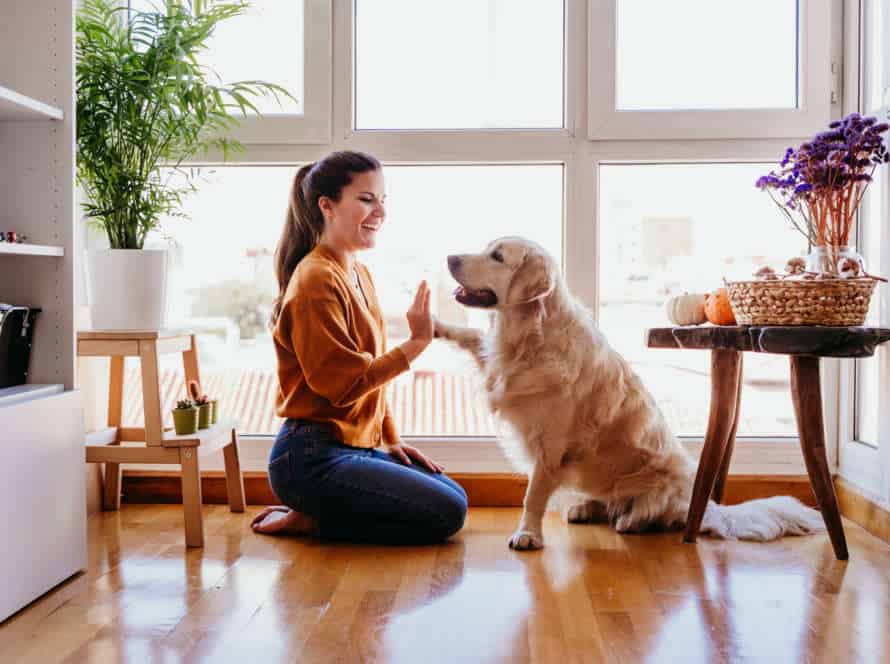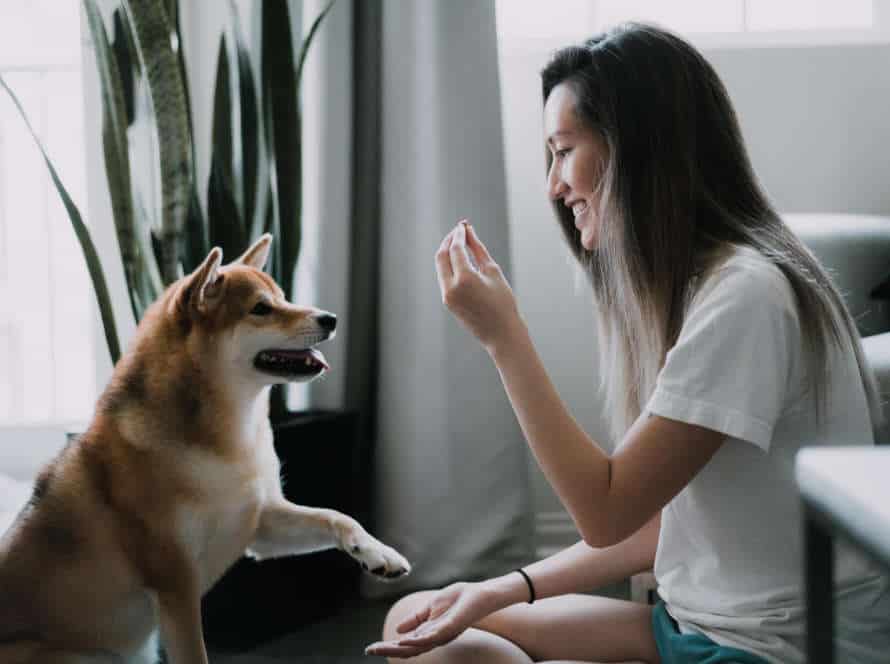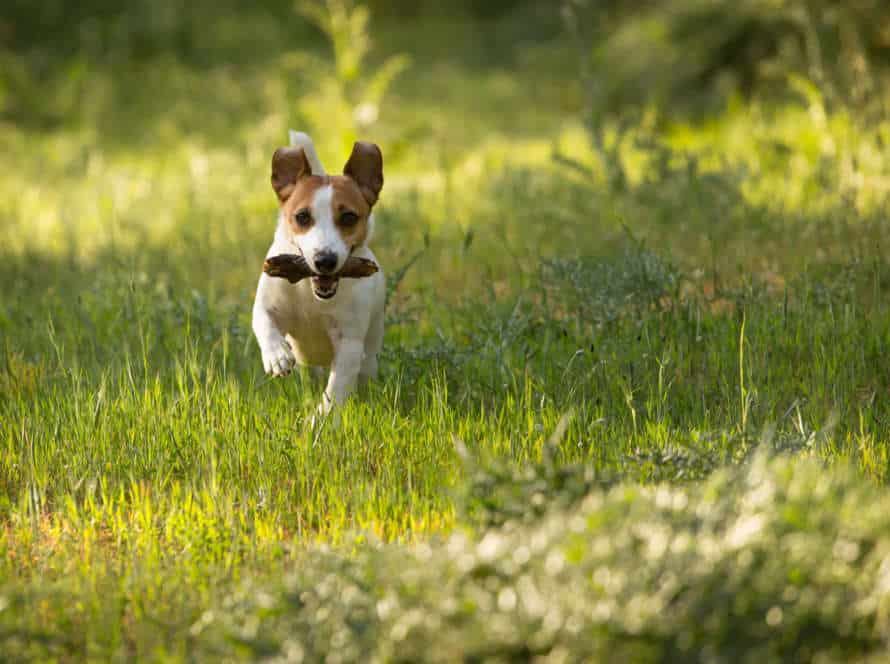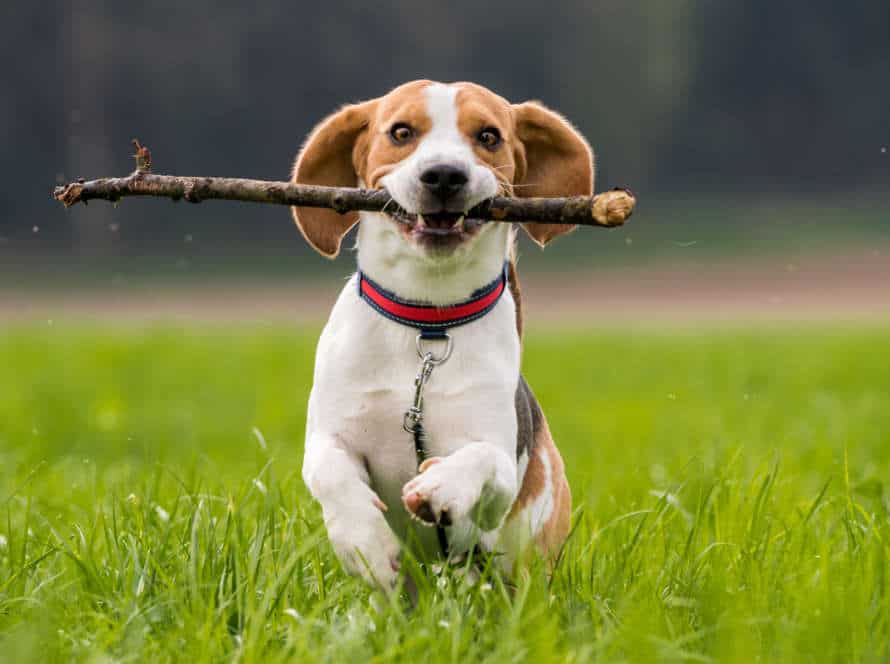Boost Your Senior Dog’s Confidence with Fun, Easy Tricks
Teach your senior pup some fun and easy tricks! Start by picking age-appropriate ones, like high-five, spin, or shake.
Reward them with treats, praise, and affection to help them learn.
Practice in a quiet and relaxed atmosphere, where your pup feels safe.
Be patient and let them learn on their own.
In time, these simple tricks can build their confidence and improve their wellbeing.
Pro Tip: Give them a reward (treat or extra love!) after each successful trick!
Mental Stimulation for Senior Dogs
Mental stimulation is just as essential for senior pooches as physical exercise. It not only keeps them focused, but it can make them feel more confident. Patience and the right guidance can help you teach your senior pup some awesome tricks!
Here are some ideas to kickstart the fun:
Benefits of Mental Stimulation in Senior Dogs
Mental stimulation is essential for elderly pooches – it helps keep their cognitive abilities sharp, keeps boredom and depression away, and promotes overall health and welfare. Engaging in tricks which are both fun and simple can boost their self-esteem, stimulate their senses, and strengthen the bond between you and your senior pup. Here are some benefits of mental stimulation for senior dogs:
- Enhances mental alertness and memory.
- Fights stress, anxiety, and aggression.
- Keeps boredom and depression at bay.
- Gives seniors a chance to be physically active and burn calories.
- Strengthens the bond between elderly dogs and their owners.
Boost your senior dog’s mental stimulation by incorporating activities such as hide and seek, treat puzzles, and scent games. Pro tip: Rewarding senior dogs with treats or praise during mental stimulation can encourage positive behavior and make the experience more enjoyable for them.
Importance of Mental Stimulation in Increasing Confidence
Mental stimulation is essential for a dog’s wellbeing – especially seniors. Engaging them in fun, easy tricks can boost their confidence. This works by helping to reduce anxiety and confusion. It also gives them a sense of purpose and accomplishment. Plus, it strengthens your bond and communication.
Some fun tricks to try are high-fives, spins, and speaking on command. Reward your pup’s efforts with treats, praise, and affection.
Types of Mental Stimulation Activities for Senior Dogs
As dogs age, exercise may become harder. But, mental stimulation activities can help keep them active. Here are some ideas:
- Puzzle toys – they must solve puzzles to get rewards.
- Simple tricks – teach them ‘shake’ or ‘rollover’.
- Scent work – hide treats and toys for them to find.
- Storytelling – use different voices and sounds.
Remember their physical and mental limitations.
Trick Training for Senior Dogs
All dogs can get mental and physical exercise benefits, no matter their age. Tricks are a brilliant way to keep their brains engaged, ward off boredom and strengthen their self-esteem. This is true for adults too!
Let’s see how to include tricks in a senior dog’s life.
Benefits of Trick Training in Senior Dogs
Trick training is great for senior dogs! It gives them physical and mental stimulation, and boosts their confidence. Age-related issues like arthritis or hearing loss can make daily life hard. Trick training can help with that.
Here are the benefits:
- Mental stimulation: keeps the mind active, prevents cognitive decline.
- Socialization: time to interact with owners and other dogs.
- Physical exercise: helps keep senior dogs active and healthy.
- Confidence booster: fun and rewarding, makes them feel capable.
It’s not only for puppies – senior dogs can learn easy tricks.
Pro tip: use treats or rewards to positively reinforce the trick and keep your senior dog motivated.
Importance of Trick Training in Boosting Confidence
Trick training is great for giving senior dogs more confidence! As they age, they start to become less active. Trick training can give them mental and physical stimulation. It’ll also help their cognitive function and confidence.
Here are some reasons why it’s important:
- Makes them feel accomplished and encourages good behaviour.
- A great way to bond and improve their quality of life.
- Helps with mobility and flexibility.
- Reduces anxiety and increases socialization.
- Can be done at home and doesn’t require much effort.
By doing fun, easy trick training with your senior dog, you can make them happier and better mentally.
Easy Tricks for Senior Dogs
Trick training for senior pups is a marvellous way to give ’em confidence. Plus, it’ll keep ’em mentally sharp and improve their enjoyment of life in an enjoyable way.
Here are some easy tricks for senior dogs you can teach them:
- “Touch”: Ask your pup to touch their nose to your hand, a target stick or an object.
- “Spin”: Lure your doggo to make a circle using a treat or toy.
- “Shake”: Ask your pup to give you their paw and shake it up and down.
- “Roll over”: Make your pup lie down and lure them to roll over onto their back.
Keep in mind to use positive reinforcement techniques, such as treats and praise, to motivate your senior pup to learn these new tricks. Also, consider your pup’s physical limits, and always consult a vet before you start any new training activities.
Agility Training for Senior Dogs
Agility training is a fantastic way to give your ageing pooch a confidence boost! Plus, it’s a fun way to help your pup learn new skills and stay active. Training seniors doesn’t have to be difficult or tiring. You can use simple activities and tricks to keep them feeling young, lively, and involved. Here are some ideas!
Benefits of Agility Training in Senior Dogs
Agility training has lots of perks for senior dogs. These include physical exercise, mental stimulation, and more self-assurance. Here are the main advantages:
- Physical exercise: Agility training gets your elderly pooch moving. This is essential for keeping their mobility and overall health in check, especially if they have joint problems or arthritis.
- Mental stimulation: The activities involved in agility training challenge your dog’s mind, preventing cognitive decline and keeping them sharp and alert in their golden years.
- Increased confidence: Teaching new tricks and completing agility courses can give your older pup a confidence boost and sense of achievement which may lead to better behavior and a happier attitude.
Pro tip: Before starting agility training with your senior pup, consult your vet to make sure they are in good condition and physically able to do this kind of activity.
Importance of Agility Training in Boosting Confidence
Agility training is an awesome way to give senior dogs more confidence. It keeps them physically and mentally active, and strengthens their connection with their owners. Benefits include:
- Better physical and mental health. Exercise is great for a dog’s heart, muscles and joints. It also stimulates their mind and helps avoid boredom.
- Improved obedience skills. Agility training teaches senior dogs to follow commands and stay focused.
- Boosts confidence. Agility training challenges senior dogs to do things they might not otherwise do. This helps them cope with the anxiety of aging.
- Better bond with owners. Doing agility training together builds trust and enhances communication.
Start simple with jumps, weaving, tunnels and balancing. As the dog gains confidence and skill, you can move on to more advanced tricks.
Low-Impact Agility Exercises for Senior Dogs
Low-impact agility exercises can be beneficial for senior dogs. They can help with their physical and mental health, as well as boost their confidence and bond with you, their owner. Here are some fun and easy tricks to try:
- Balance exercises: Teach your pup to stand on a balance pad or cushion. This strengthens their core muscles and improves balance and coordination.
- Obstacle course: Set up a simple obstacle course in your backyard. Place cones or low jumps. Encourage your dog to go around the course, weaving through the cones or jumping over the obstacles.
- Hide-and-seek: Hide treats or toys around the house or yard. Let your senior dog find them. This will stimulate their sense of smell, mental agility, and physical activity.
Pro tip: Ask your vet before starting any new exercise routine with your senior dog. Monitor them closely during activities, so they feel safe and comfortable.
Remedial Socialization for Senior Dogs
Socialization is vital to a doggy’s life, especially in their later years. Remedial socialization is the term used to describe activities to help senior pups become more confident and content. Let’s review the advantages and disadvantages of remedial socialization for senior dogs and discover some simple, enjoyable tricks that can increase a senior dog’s trust in their environment.
Benefits of Remedial Socialization in Senior Dogs
Incorporating social activities into the routine of senior pups can benefit them both physically and emotionally. Such activities can be basic and fun, like tricks and games, which help build confidence and overall well-being.
Here are some benefits of having a senior pooch partake in social activities:
- Reduced anxiety and depression: Activities can help relieve symptoms of anxiety and depression.
- Increased physical activity: Going for walks, playing, or performing simple tricks can help senior dogs stay active, which is vital for their health.
- Better cognitive function: Doing social activities can help improve cognitive function and memory in senior dogs.
- Improved social skills: Senior dogs that join in on social activities can become more comfortable around other animals and people.
Pro tip: Always consult your vet before initiating any new exercises or activities with your senior pup.
Importance of Remedial Socialization in Boosting Confidence
Remedial socialization is essential for boosting a senior dog’s self-assurance and helping them adjust to new environments. As dogs age, their mental and physical abilities may weaken. They could become more withdrawn, reclusive, and anxious. Activities that help remedial socialization can make your senior dog more secure and interested in their surroundings and owners. Here are a few fun and straightforward tricks to attempt:
- Paw Targeting: Utilize treats or a clicker to reward your dog when they touch a ball or target with their paw.
- Hide and Seek: Hide treats or toys and urge your dog to find them. This game stimulates their problem-solving abilities and augments their self-esteem.
- Trick training: Teach your dog a new trick, such as rolling over or playing dead. The process of learning new skills tests their mind and bolsters their self-confidence.
By regularly taking part in these activities, you can help your senior dog live a more content and fulfilling life.
Techniques for Remedial Socialization in Senior Dogs
Remedial socialization is a great way to help older dogs be less scared and more confident. Here are some tips:
- Take your senior pup on short, familiar walks and reward them with treats and love when they’re good.
- Let your senior pup meet other dogs in controlled places, like a dog park.
- Play fetch and hide-and-seek with them to give them physical and mental exercise.
- Enroll your senior pup in an obedience class to help them learn good habits and socialize better.
- Associate positive things with social situations by giving your pup attention, praise, and treats during and after each meeting.
Massage Therapy for Senior Dogs
Massage therapy is a great way to help your senior pup relax and ease any muscle stiffness. It can also boost their confidence! Showing them that, even at an old age, they can still learn new skills. Massage therapy is an enjoyable and simple activity for your senior pup, so let’s look into its benefits!
Benefits of Massage Therapy for Senior Dogs
Massage Therapy can bring lots of benefits for our senior buddies. Such as:
- Reduced pain & stiffness. Massage can ease tense muscles and joints, helping with issues like arthritis.
- Improved circulation. Nutrients, oxygen and waste can be moved around more easily.
- Increased relaxation. Senior dogs can feel more relaxed and calm, which can mean better sleep and appetite.
- Builds confidence. Massage can help our furry friends feel more capable, and able to do more activities.
Pro Tip: Always check with your vet before any massage therapy or treatment for your senior pup – certain conditions might need more specific massage techniques.
Importance of Massage Therapy in Increasing Confidence
Massage therapy is great for giving a boost to confidence – in both humans and canines, especially senior dogs! Benefits of massage therapy for senior dogs include: better flexibility, stress/anxiety relief, better blood flow/lymphatic drainage, and relaxation.
Plus, there are fun, easy tricks you can teach your senior pup to increase their confidence. For instance: walking through an agility tunnel or touching a target with their nose. These tricks give them physical and mental stimulation – helping to build their confidence and overall well-being.
If you’re not experienced with massage therapy or dog training, seek out a professional! They can make sure the techniques used are safe and effective for your senior pup’s needs.
Regular massage therapy and confidence-boosting activities can really improve the quality of life for senior dogs and their human companions. Pro tip!
Steps to Massage Therapy for Senior Dogs
Massage therapy is a great way to boost health and happiness in senior dogs. Here’s how to give your pup a calming massage:
- Create a peaceful, secure setting.
- Start by petting and stroking your pooch, focusing on neck and shoulders.
- Then, move to lower back and legs.
- Use your fingers and palms to gently press, knead and rub in circles.
- Observe your dog’s reactions and cues, like whining or tension. Then, adjust pressure and speed.
- Give extra attention to sore muscles or joints.
- Keep the session enjoyable and brief.
- Reward good behavior with treats and praise.
Regular massage therapy can improve circulation, reduce stress, and strengthen your bond.
Frequently Asked Questions
Q: Can tricks really boost my senior dog’s confidence?
A: Yes! Learning new tricks can help your senior dog feel more accomplished and confident. It also provides mental stimulation which can improve overall well-being.
Q: What kind of tricks should I teach my senior dog?
A: Stick to easy tricks that your senior dog can physically handle. This could include things like waving, rolling over or giving a high five. If your senior dog has any physical limitations, make sure to choose tricks that won’t cause them any discomfort.
Q: How many tricks should I teach my senior dog?
A: Start with one or two tricks at a time and gradually add more as your senior dog becomes more comfortable. Be patient and have fun with the process.
Q: Can training be too strenuous for a senior dog?
A: Yes. Be mindful of your senior dog’s physical limitations and don’t push them too hard. Keep training sessions short and positive.
Q: How often should I train my senior dog?
A: Short and frequent training sessions work best for senior dogs. Aim for about 10-15 minutes, 1-2 times a day. Consistency is key to seeing progress.
Q: What if my senior dog doesn’t seem interested in learning tricks?
A: Not all dogs enjoy tricks, and that’s okay. If your senior dog isn’t interested, try finding other ways to provide mental stimulation like puzzle toys or hiding treats for them to find.







